
To most people, Burdock does not offer a particularly pretty sight, though some might be impressed by its sheer size: burdock can grow more than to 5 foot tall and its huge, expansive, heart-shaped leaves can reach over a foot in length. A distinctive and unmistakable plant, burdock certainly ranks among the tallest and most space consuming herbs, sporting extraordinarily big leaves as well as the stickiest burs. Yet, considering it many values, not the least of which is that it gave the inspiration to the invention of Velcro, it appears to be chronically undervalued. Burdock is rarely welcome in any yard, much less in carefully groomed gardens, though at least the bees and butterflies appreciate it for its generous supply of nectar.

The plant makes its presence known early in the spring, when it begins to sprout a number of large low lying, heart shaped leaves that somewhat resemble those of rhubarb, for which they are sometimes mistaken. The plant is biennial, which means that it does not send up a flowering shoot until the second year. Opinions as to the best times to collect the various parts of Burdock vary according to local traditions. As a rule of thumb it is better to collect the aerial parts while the vital energy is rising - i.e. leaf stalks and leaves are collected before the leaves are fully developed, while the roots should be collected when the vital energy is most concentrated within - i.e. in spring or autumn, preferably during the first year, before they become too old and tough.

Burdock belongs to those special kinds of plants that offer both nutrition and healing benefits, though western cuisine, and for the most part western herbalism has largely ignored this wonderful herb. The Japanese are about the only culture that truly appreciates Burdock as a wholesome, medicinal food - they even produce it commercially and sell it at the market under the name of 'Gobo'. One can sample it at Japanese Restaurants where it can sometimes be found as an ingredient of sushi rolls. The key to its popularity among the Japanese may lie in the well-kept secret of Burdock's lesser known qualities: It is rumoured that Burdock gives strength and endurance, especially with regard to sexual stamina, which has earned it a reputation as an aphrodisiac. Considering its essential character it is easy to understand why:
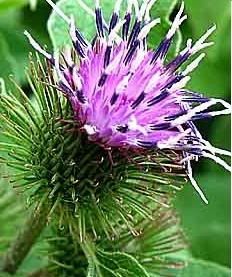
Burdock's overall mode of action can be described as purifying. It has a stimulating effect on the metabolism and gently, but persistently activates and tones all the organs of elimination, thus inducing a process of inner cleansing. It's energizing quality is hard to describe, but can be likened to putting a good, sustaining log on the fire, such as oak or apple, one that burns slow and steady and develops an intense, but even heat, as opposed to e.g. pine, which burns in a flash. Burdock's ethereal fire fuels all the organic processes, thus improving, cleansing and toning the whole body. However, it must be kept in mind that the fresh herb/root is infinitely more powerful than the dried material.
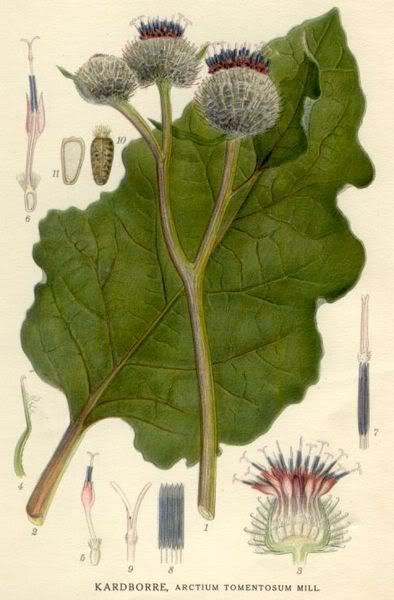
The leave stems can be peeled and cut and either added raw to salads, or added to various soups, stews or bakes, or even made into a candied sweet. Leaves are rarely used for food as they soon become too bitter and tough to be enjoyable. The roots however, are delectable, although they require some determined effort to collect, as they are long and deeply anchored. They usually need to be dug out. Once brought to the surface they must be thoroughly cleaned and peeled to cut away the tough outer rind. What remains can be prepared as a delicious root vegetable, with a slightly sweet, nutty flavour that some have likened to Jerusalem Artichokes. The roots are excellent when pureed or added to stews and soups. As a healing food, the root is particularly recommended for diabetes sufferers, as it is rich in inulin and helps to even out blood sugar levels.
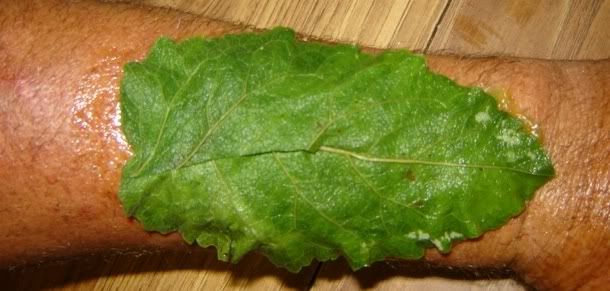
Medicinally, Burdock root is thought of as a 'liver herb' and it is particularly recommended as blood cleanser for skin conditions such as acne, eczema, psoriasis and other skin conditions. Both, the fresh, grated root or the mashed fresh leaves can be applied as a poultice to wounds, bruises and badly healing sores. Simultaneously a tea or decoction of the root can be used internally to facilitate inner cleansing and support liver and kidneys. The whole plant has a tendency to draw impurities from the body and aid the healing process. Burdock root and Nettle root extract are said to be helpful as a hair tonic to prevent loss of hair.
Traditionally, Burdock is also considered a powerful anti-tumor herb and various salves and decoctions have been prepared with it as a home treatment for this purpose. One of the better-known preparations that fall into this category is a tea known as 'Essiac' of which Burdock is a key ingredient. German researchers have confirmed anti-tumor activity in all parts of Burdock as long ago as 1964.
The seeds are also considered medicinally active though according to older herbals one should avoid inhaling the tiny hairs surrounding the seeds as these are said to be toxic (Perhaps irritant?). The seeds can also be used as a poultice, though they are more frequently recommended as a tea, especially for kidney complaints. Modern herbal medicine usually only makes use of the roots.
recipes.GIF (1K)
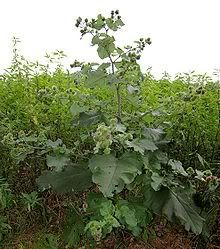
Creamy Burdock leaf stalks
The leaf stalks of the first year's growth make a fine vegetable. Cut off the leaves and chop the stalks into smallish chunks. Steam in a little water with some salt and sugar until tender (no longer than 10 minutes). Make a rue with the cooking water a little butter and some oatmeal. Add some crème fraiche, an egg or a little cheese.
Burdock Bake
The same kind of idea can be modified to make a kind of burdock stalk bake: Prepare some Bulghar wheat and mix with the cooked leaf stalks (take care not to overcook the stalks). Make a 'custard' with 2 eggs, crème fraîche, a little milk and melting cheese, mix with the Bulghar and burdock and bake in the oven for about 30 minutes. This recipe can be adjusted to taste: add other vegetables, such as onions, sliced carrots and garlic, and season to taste.
Au Gratin
Similarly, Burdock stalks can be prepared 'au gratin'. Leave out the Bulghar wheat and just layer the pre-cooked stalks. Pour a mixture of seasoned eggs and crème fraîche over the stalks and sprinkle with a fine gouda or similar melting cheese. Bake in the oven for about 25 minutes.

The leaves are usually a bit bitter and most people don't like them as a vegetable. However, the young leaves are usually palatable, especially when mixed with other, milder greens or when prepared with eggs and cheese. They can also be added to soups.
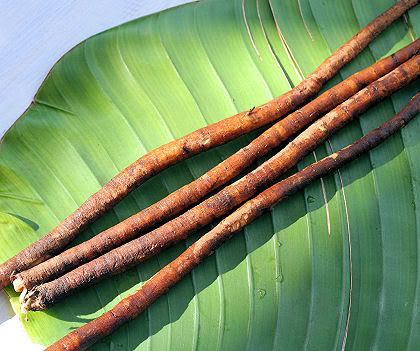
The roots are hard to dig for, but make an excellent root vegetable, which can be roasted, pan-fried, mashed like mashed potatoes or added to soups.
Dandelion and Burdock Beer
(from 'The New Herbal' by Richard Maybe)
* 1lb young nettles
* 4oz dandelion leaves
* 4oz fresh sliced, or 2 oz dried burdock root
* ½ oz bruised ginger root
* 2 lemons
* 1 gallon water
* 1lb + 4 teaspoons demarara sugar
* 1 oz cream of tartar
* Brewing yeast (use amount according to instructions on the package)
Put the nettles, dandelion leaves, burdock, ginger and thinly pared rinds of the lemons into large pan. Add the water, bring to the boil and simmer for 30 min. Put the lemon juice, 1 lb sugar and the cream of tartar into a large container and strain on the liquid from the pan, pressing down well on the nettles and other ingredients. Stir to dissolve the sugar. Cool to body temperature. Sprinkle in the yeast. Cover the beer and leave to ferment in a warm place for 3 days. Rack off the beer and bottle it adding ½ teaspoon demarara sugar per pint. Leave the bottles undisturbed until the beer is clear - about 1 week.
Well I learned something new today! I had always thought these were poisonous and I'm sure I learned that some where along the way.
ReplyDeleteI know the birds love them! About 20 years ago when I lived in my Stone House we were overrun by Burdock and each year I had to pull many up as they were overtaking everything. I had many woodchucks that lived there and now I wonder if they were eating all the healthy burdock which surrounded their entrances. LOL It's cool that you can use it for eczema and now I think the next time I go down into the back yard I will look and see if there is any down there so I can make a poultice for my eczema. Who Knew?
Thanks Sister Love for this incredible lesson today! :)
Hope you have a supercalifragilistic day!
I love you so much!
xoxo
The resilient Burdock. Cant kill these if you try! The birds do love them as they do Thistle which is in the same family. Very good for eczema sister.Hehhehheh...I wish the same kind of day for you my wonderful sister.Blessings of peace and beauty to you .xxxx
ReplyDeleteHello, thank you for this. I had a dream to eat burdock as it will give me strength. I have been going mad trying to find it, on and off since I had the dream a few months ago. Now, I have just found some right by the A40 in Central London, but also by Little Venice and the Grand Union Canal, which are situaded or hidden just off the A40.
ReplyDeleteWhat I would like to know is, is this safe to pick. It's all running along side the canal, and I saw a flippin dog weeing up some of the plants I picked the other day and cooked (boiled/simmered for twenty minutes) and then ate!!! I keep reading that the root is the thing that you need, but I can't dig that out in this public place.
Do you know how I can get hold of some? I am in need of some serious healing as I am morbidly obese and can not give up food (bad food as in chocolate, bread, butter, cream etc etc).
Thanks so much. Joy and peace.
x